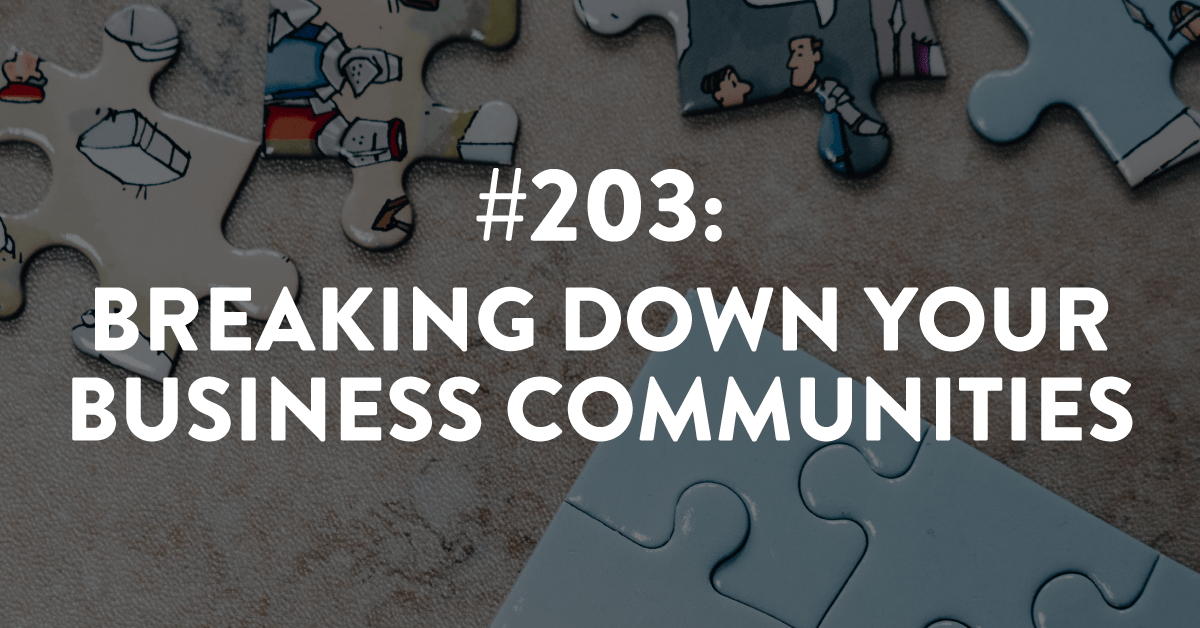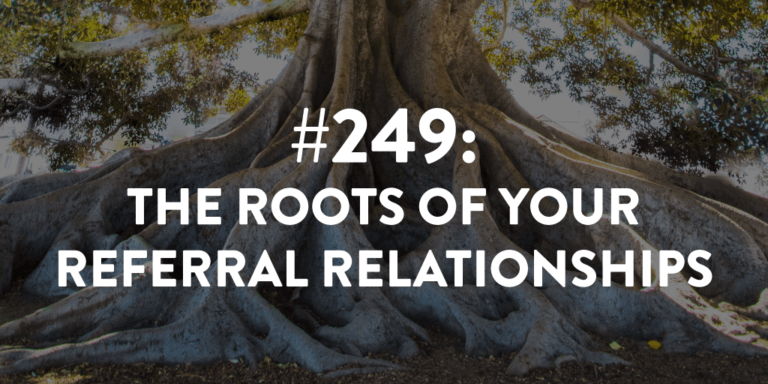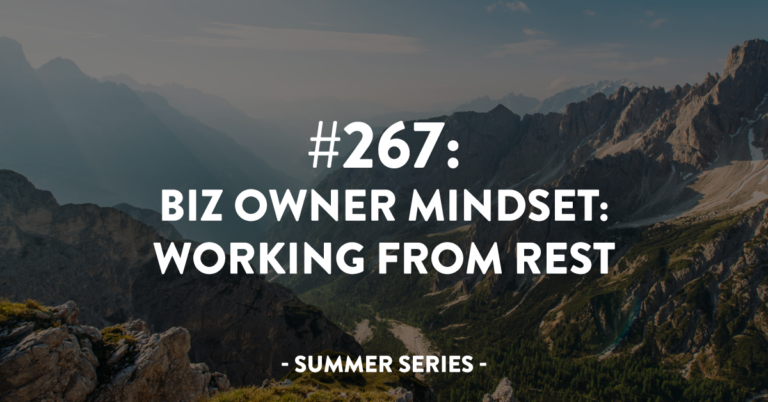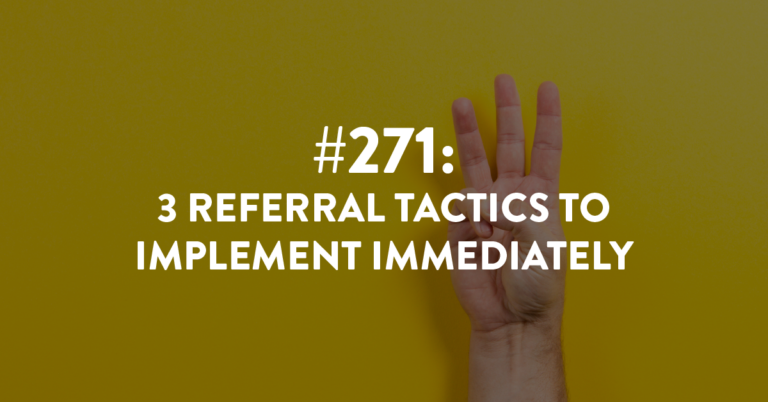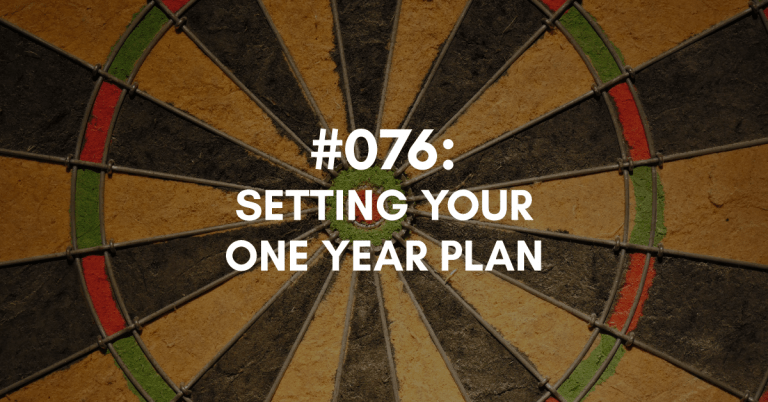Ep #203: Breaking Down Your Business Communities
So what exactly do we mean when we talk about your business’s communities—and how can we break them down so that we can make decisions based on them? That’s what we will be discussing in this episode.
I hope that you enjoyed last week’s interview with Erica Young. We talked about some of the limiting beliefs that individuals have about being proactive in how they connect with others. Specifically, one of the things she brought up was “network science.” So, today, I am going to be digging into network science and showing you how you can think about applying that to your business through a specific activity.
Share your thoughts on this episode or ask any questions you have in our Referrals Without Asking Facebook group!
Looking for Referral & Client Experience Resources:
Take the Referral Ninja Quiz to test your skills and abilities at generating referrals. (FREE)
Buy my book – Generating Business Referrals Without Asking – and learn how to generate referrals through my 5 steps. (LESS THAN $16)
Consider joining Building a Referable Business™ – a unique way to learn all of my referral strategies and tactics with ongoing weekly access to me to answer your questions and help hold you accountable! Email me for more details.
Coming Up:
Next episode is #204, and we’re going to talk about measuring metrics within your business.
Download The Full Episode Transcript
Read the Transcript Below:
Stacey Brown Randall: So what exactly do we mean when we talk about your business’s communities? And what does it mean to break them down so that you can actually make decisions based on them? Well, we’re going to talk about it today. Join me.
You are not just another hustling salesperson. You are the expert, the
resource, the valuable partner for your clients, and how you grow your
business should reflect how your clients see you.
Welcome to the Roadmap to Grow Your Business podcast. We generate
referrals without asking, build positive client experiences, and help
you take control of your business.
Here’s your charmingly sarcastic host, Stacey Brown Randall.
Stacey Brown Randall: Hey there, and welcome to episode 203 of the Roadmap To Grow Your Business podcast. I’m your host, Stacey Brown Randall. I’m going to do a quick shout out to my client and buddy, Chris Pentrack. He received 22 referrals in one quarter. I love sharing his results. This was his first quarter results from 2022. So proud of him. 22 referrals in one quarter. That’s three months, my friends. You want to know what’s even better about this? He actually started working with me at the beginning of fourth quarter last year. So fourth quarter, he took three months. He was learning the strategies. He started implementing. He started putting them into practice. And then his next quarter had 22 referrals received. I am so proud of him.
And he was learning two of my strategies, the strategies that we teach in the Growth By Referrals program and the strategy we teach in Referring Machines. So two of those strategies. All, of course, are contained in Building a Referable Business. But both of those are actually available too if you just want to do an a la carte and just learn those strategies individually. All right. So congratulations, Chris, on an awesome first quarter. Here’s to you having an amazing second, third, and fourth quarter this year as well.
So if you listened to last week’s episode, episode 202, you know that I interviewed a super smart lady. Yes, yes. I really loved my interview with Erica. If you haven’t listened to it, I really want you to go back and listen to 202 because what I’m going to talk about today is kind of, I’m piggybacking on our interview to talk and go a little bit deeper with you guys today. So I hope you enjoyed the interview with Erica, where we were breaking down some of the limiting beliefs that hold us back from connecting with others. But I love it because the way that Erica researches it and pays attention to it and pulls out her learnings and then her applications and her tactics, of course, it’s all because there’s science behind it.
And I love it when we can add in the science piece behind relationships and networks and communities and businesses because, of course, that is what my generating referrals naturally, my methodology is all about. When I teach people how to generate referrals naturally without manipulation, without incentivizing, and without even asking, it all comes down to half a dose of common sense and another piece of that dose that is very much based on the science behind it, which actually it makes me think that there’s an episode on the scientific piece coming up later on. I’ve got it kind of mulling around in my head. I’m starting to think that maybe I don’t talk about it too much. It’s probably something I should talk about it. So we’ll talk about it here on the podcast as well coming up.
But if you listen to that interview with Erica, we talked about some of the limiting beliefs that people have about actually being proactive in how they connect with others. And one of the things she talked about from that science piece was this concept of network science. So I want to dig in a little bit on network science, and then I want to show you how I want you to think about applying that to your business with an actual exercise, an activity I want you to do.
Okay. So this concept of network science, I really want you to understand what it means first. So bear with me while I go a little academic for a minute. My graduate degree days, or my graduate school days and my adjunct professor days are coming out of me. I kind of can’t help myself. But I want to talk a little bit about network science, a little bit. I’m not going to go too terrible deep. And then I’m going to talk about how we’re going to apply this to your business because that’s what you’re here for.
So again, if you haven’t listened to my episode with Erica first, please hit pause right now, go back to episode 202, listen to that and come back to listen to this one. It’ll make way more sense.
All right. So network science was something that Erica talked about and that comes into this whole idea of building business communities within your business. So network science is the study of complex networks, and one of those complex networks being our social networks. Because let’s be honest, people make it complex, right? Okay. So social networks is a social structure and it’s made up of three things.
It’s made up a set of social actors. Now, actors is the academic term. It’s like individuals or organizations, right? So it’s a set of people. It’s a set of organizations, right? And it’s a set of these didactic ties, which is really all about the strength of that relationship that you have. And then other social interactions between those “actors,” right? The individuals.
So again, I’m not trying to go too deep here. At a high level what I want you to understand, we’ll go a little deeper in a future episode. But what I want you to understand is when you do an analysis of social networks, it’s really about identifying patterns within your relationships, locating what influences those relationships, and examining the dynamics behind those relationships.
So when you think about this… Let me just make sure I’ve said this clearly enough for everybody to get. If not, you may want to hit rewind just a little bit to hear me talk about this. But social networks is just a social structure that’s made up of people, how they’re tied together, and their interactions between them. It’s relationships folks. Right? So if we’re applying social networks to your business, here’s what I want you to think about.
So if we’re applying social networks to your business or business communities, as Erica called them, and what I typically just refer to as relationships, so when we’re applying that to our business, this all comes down to the strength of your relationships. That is most important for us to keep in mind. So as we’re thinking through, “Okay, there are social networks within your business.” Yes. They’re your relationships with groups of people. It really kind of all boils down to that. I love how academics can use big words like didactic ties, right? And they can use big words like that and structure and construct and all the big words. But at the end of the day, it’s the strength of your relationships.
Now, for anybody who probably has ever dove into social networks or they’ve ever dove into network science, you’re like, “You just took complex things and minimized it down to a sentence of it’s the strength of your relationships.” I did. And that’s not to insult anybody who lives this stuff. But I want you guys to be able to understand how the science piece actually shows up every day in your business when you’re probably not even paying attention to it, that there is so much from a psychology, a sociology, a behavioral economics, and a network science perspective that actually shows up in how you do business and how you have relationships with people.
So what I want you to do for the purpose of this episode is I want you to consider all of the communities. I’m using air quotes. You can’t see. I want you to consider all of the communities, right? Other word could be social networks. Another word could be relationships. But I want you to consider all of the communities or relationships your business has. And then the strength of those.
Now, I typically talk about relationships with the referral sources, right? With your referral sources. That’s super, super important. So obviously, for me, number one is your referral sources is one of your business’s communities. It’s a group of relationships, right? But we’re going to kind of put it in a bucket or we’re going to bucket these things out. So your relationship or the community with your referral sources is one.
But here are some others to consider. Another one is, of course, your clients. This is a pretty obvious one, right? Obviously, you’ve got this community within your clients as well. That doesn’t necessarily mean all your clients are connected. It just means that’s the label of how they interact with your business is because they are a client or because they are a referral source. But you’ve also got the community of employees if you have employees, or if you’re a solo like me, then you don’t have employees, but I bet you’ve got contractors or vendors. And I don’t mean the vendor like the software that you pay that you never talked to anybody at, but I mean maybe it is your contractor that does your graphic design or the contractor that does the bookkeeping for you or the CPA or the attorney, right? So you do have another community within your contractors.
You may also have a community, one that I always like to pay attention to is your business besties. And maybe you don’t call them that, your business besties, besties doesn’t sound very professional to you. But it’s the people that you would put into a mastermind or it’s the people you go to when you’ve got questions or you’re seeking advice from, right? So business besties.
And then there’s maybe your networking buddies. It’s the people you are in groups with, that you’re paying dues to, that you’re actually in this group with, or it’s the people that you see consistently when you go to different networking groups, but they become the familiar faces that you’re kind of seeking out in those moments. They’re kind of like the folks you expect to see there. So they’re your networking buddies. That’s another community within your business.
And then you have your loose ties. And loose ties I think is such a great concept. It comes from Erica’s work. But the idea behind loose ties is the folks that you don’t actually know that well, but they do amazing things for your business. And you can’t plan for them to happen. They just happen. Sometimes I like to think of loose ties as your guardian angels.
I think about one chance meeting at a conference to meet Tom Schwab who owns Interview Valet. And he and I happened to have a conversation at that conference. And then that led him later to refer me to Morgan James, the publisher of my book. That was all just, he’s just, Tom’s just a little guardian angel, right? He’s just a loose tie. It’s not someone I talk to often. I probably don’t even talk to him every year, but we have gotten on the phone since then and just caught up. And he’s a loose tie, but he’s still an important part of my business’s community.
So your business is made up of lots of different types of communities. Like we said, referral sources, clients, employees, contractors, business besties, or whatever you want to call them, your networking buddies, and then your loose ties as well. These are people that you seek advice from. Who are those people? These are maybe people that you collaborate with on projects. Maybe these are people that you generate referrals from, or that, of course, are your clients.
So when you think about the communities of your business, I want you to think about it in terms of these buckets. And then I want you to identify who they are. And it doesn’t mean that every contractor you work with would actually end up in a bucket and you would take through this process. But I want you thinking outside of just referral sources. I want you starting with them, but I want you thinking outside of just referral sources and really thinking through the communities within your business.
And I love calling them communities. I always just call them the groups of people, right? The relationships we have with people. But I think Erica’s on to something here by calling them communities because they really are, because we are going to label them with a commonality of the fact that they fit within this one group. So who are they? Right? So if you have referral sources, who are they? You should already know if you’ve been listening to this podcast and applying anything that I’ve taught you over the last three and a half years, right?
But who are your contractors? Who are the people you seek advice from? Who are the people you collaborate on projects with? Who are those business folks that you go to when you have a question about what you should do within your business? Who are the people you see at networking groups consistently and you’ve formed relationships with them?
First, I want you to figure out what your categories of these communities are. And then I want you to determine who the people are within them. And then you determine the strength. And you can kind of create your own rating scale that you want to from a strength perspective. But how strong is the relationship with them? And it doesn’t mean your strength of relationship comes because you see this person in a networking group every single week, right? There could be other ways that you measure the strength of that relationship. A big one for me is if I called them, would they answer? Now, that doesn’t mean they wouldn’t be able to answer. It would just mean that they wouldn’t screen me on purpose and they would, if they missed my call, they would actually call me back. So that’s kind of how I determine strength. You can determine strength how you want to.
And then what you can do is do a mapping exercise, looking at these different communities and the strength of relationships and how they are then intertwined and tied together. And then you can take that one step forward by a mapping exercise to really see how your business is interconnected within its communities. And then, obviously, you can look at this in any individual community as well.
I’m personally super excited to do this from a referral source perspective with my Building a Referable Business members, the folks who are in my BRB program, Building a Referable Business. I’m excited to do that with them a little bit later this summer. I think it’ll be awesome to kind of just dig in and look at their mapping from a referral source perspective and to see on a mapping, which means usually visual, right? So it’s usually some type of visual. It’s not bullet points. It’s not paragraph formats. It’s usually kind of like mapping it out with circles that are connected to each other and things. If you just look up mind mapping software, it’s going to come to you. We’ve talked about this in a previous episode as well. But just looking at mapping out that of your business communities, I think that’s a really powerful thing that you can do.
And some things it’s just like, “Hey, I work with this one person, but the strength of our relationship is great because we work together.” But that doesn’t necessarily mean it goes anywhere past that. I mean, some things are just that, right? I think about some of the folks that I work with that I really couldn’t run my business without them, bless them. But at the end of the day, if I wasn’t paying them, I may not reach out to them just to have a relationship with them. And then there’s other people that I’ve never hired, they’ve never hired me, but there’s a kindred spirit there. And when I have a question, I reach out. And when they have a question, they reach out to me. And we support each other in that. And so those are the communities we’re talking about. And that’s the strength we’re talking about. Just getting an idea of you breaking down what your business communities look like based on the strength of them, and then taking it a next step if you want and mapping it out.
All right. So of course, the show notes for this episode is staceybrownrandall.com/203. We’ll link to the resources on the show notes page for this episode so you can kind of go back in. And of course, the transcripts will be there too if you’d rather just download the transcripts and then look at exactly these categories that I’ve mentioned and exactly the three steps I want you to go through with who are they based on their category or their community label, what’s their strength of that relationship, and then maybe even mapping out how they’re interconnected within that community or within the communities amongst themselves as well.
All right. I think it’s a really cool exercise. It’s not something you’re going to knock out in 30 minutes. So you’re going to have to spend some time on it. Maybe find a lazy summer day when, I know some of you just laughed out loud, but if you have lazy summer days, maybe find one of those, or you just spend a little time just on a piece of paper jotting this out. You don’t need to get all technical and get out the mind mapping software just yet. Okay.
I can’t wait to hear from you if you do do this. Please hop into our Referrals Without Asking Facebook Group and let me know if you did a little bit of this in terms of breaking down your business communities and paying attention to the strength.
All right, next week’s episode is episode 204, and we are going to talk about measuring metrics within your business. So somewhat similar, but we’re going to have a conversation regarding the right metrics to measure within your business and what that looks like for you. But until then, take control and grow your business. Bye for now.
Thanks for listening to the Roadmap to Grow Your Business podcast. To
access all resources and links mentioned in today’s show, and to
connect with Stacey, head over to www.staceybrownrandall.com.

